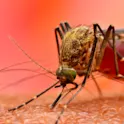Featured news
12 Mar 2024
Beer byproduct behind Marmite could help us recycle metal waste
Scientists use spent brewer’s yeast, left over from manufacturing beer, to filter out metal from waste streams.
Featured news
12 Mar 2024
Scientists use spent brewer’s yeast, left over from manufacturing beer, to filter out metal from waste streams.

Environment
06 Nov 2023
by Deborah Pirchner, Frontiers science writer Image: Shutterstock.com At Frontiers, we bring some of the world’s best research to a global audience. But with tens of thousands of articles published each year, it’s impossible to cover all of them. Here are just five amazing papers you may have missed. Carnivore territories might soon overlap – and some species profit more than others Some of Europe’s large carnivore populations, including jackals and lynxes, are growing and expanding their territories. The golden jackal, a wolf-like generalist that once occupied only the Balkan area, is currently expanding its territory. At the same time, the Eurasian lynx, a specialized predator previously hunted close to extinction, is slowly recovering. Writing in Frontiers in Ecology and Evolution, researchers have now modeled jackal and lynx distribution in Europe for current and future scenarios. Currently, it is estimated that the overlap of jackal and lynx territories is 13%. This overlap is likely to increase, given both species’ expansion. The researchers’ findings showed that both predators expanding their territories, leading to a dynamic where they coexist for the first time, may favor one species and threaten the other: Their predictions show an increase in habitat suitability for the golden […]

Engineering
14 Jul 2023
by Angharad Brewer Gillham, Frontiers science writer Image courtesy of the Hub for Biotechnology in the Built Environment Scientists have developed mycocrete, a paste made with the root network of fungus called mycelium, as a building material. Injecting this into a knitted textile framework creates a composite material which is stronger and more versatile than previous biomaterials made of fungi and could eventually be used to construct lightweight buildings with low environmental impact. Scientists hoping to reduce the environmental impact of the construction industry have developed a way to grow building materials using knitted molds and the root network of fungi. Although researchers have experimented with similar composites before, the shape and growth constraints of the organic material have made it hard to develop diverse applications that fulfil its potential. Using the knitted molds as a flexible framework or ‘formwork’, the scientists created a composite called ‘mycocrete’ which is stronger and more versatile in terms of shape and form, allowing the scientists to grow lightweight and relatively eco-friendly construction materials. “Our ambition is to transform the look, feel and wellbeing of architectural spaces using mycelium in combination with biobased materials such as wool, sawdust and cellulose,” said Dr Jane Scott […]

Featured news
09 Jun 2023
by Angharad Brewer Gillham, Frontiers science writer Image/Shutterstock.com Evidence is mounting that head impacts in American football can lead to devastating neurological illness. Scientists searching for ways to protect players have developed a helmet containing liquid shock absorbers that cuts the impact of blows to the head by a third compared to existing models. Millions of people in the US are concussed every year playing sports. Players of games like American football are at particularly high risk for injuries that can have devastating long-term consequences. Stanford University scientists working with the company Savior Brain have now designed one potential way of protecting players: a helmet containing liquid shock absorbers that could reduce the impact of blows to the head by a third. “Most of the members of our team have a personal connection to traumatic brain injury and we care deeply about ensuring long-term athlete brain health,” said Nicholas Cecchi, a PhD candidate at Stanford University and lead author of the study in Frontiers in Bioengineering and Biotechnology. “Concussion and repeated head impacts are still a major problem in contact sports, and we believe that improved helmet technology can play an important role in reducing the risk of brain injury.” […]

Featured news
30 May 2023
by Angharad Brewer Gillham, Frontiers science writer Image/Shutterstock.com Scientists have discovered that the recoil created by the flexible arch of human feet helps position our legs in the optimal posture for moving forward in bipedal walking. Understanding how our joints help modern humans walk upright could help us track the evolution of bipedalism and improve care for patients with foot problems. A new study has shown that humans may have evolved a spring-like arch to help us walk on two feet. Researchers studying the evolution of bipedal walking have long assumed that the raised arch of the foot helps us walk by acting as a lever which propels the body forward. But a global team of scientists have now found that the recoil of the flexible arch repositions the ankle upright for more effective walking. The effects in running are greater, which suggests that the ability to run efficiently could have been a selective pressure for a flexible arch that made walking more efficient too. This discovery could even help doctors improve treatments for present-day patients’ foot problems. “We thought originally that the spring-like arch helped to lift the body into the next step,” said Dr Lauren Welte, first author […]

Environment
15 Mar 2023
By Deborah Pirchner, Frontiers science writer Image: Shutterstock.com At Frontiers, we bring some of the world’s best research to a global audience. But with tens of thousands of articles published each year, it’s impossible to cover all of them. Here are just five amazing papers you may have missed. What praise and flattery does to our brains Both sincere praise and flattery are rewarding in different ways, but the various effects of these types of praise are not obvious. Now, researchers from Japan have published an article in Frontiers in Human Neuroscience in which they examined the brain activity of participants who received sincere praise or flattery after performing a visual search task. Using neuroimaging, the researchers found different effects of praise. The activation of the part of the brain modulating reward and pleasure processing was higher when participants received sincere praise than when they received flattery. The scientists also observed a socio-emotional effect, based on the positive feedback conveyed by praise. Altogether, they found that the neural dynamics of the rewarding and socio-emotional effects of different types of praise differ. Article link:https://www.frontiersin.org/articles/10.3389/fnhum.2023.985047/full Fish bone matrix may help heal bone defects Biocompatibility and osteogenic activity are properties of decalcified bone […]

Engineering
28 Feb 2023
By Mischa Dijkstra, Frontiers science writer Scientists have shown that the biomass of 12 previously unstudied strains of cyanobacteria from around the globe is efficient at the biosorption of the rare earth elements lanthanum, cerium, neodymium, and terbium from aqueous solutions. This allows these rare elements, for which demand is steadily growing, to be collected from wastewater from mining, metallurgy, and the recycling of e-waste, and reused. Rare earth elements (REEs) are a group of 17 chemically similar metals, which got their name because they typically occur at low concentrations (between 0.5 and 67 parts per million) within the Earth’s crust. Because they are indispensable in modern technology such as light emitting diodes, mobile phones, electromotors, wind turbines, hard disks, cameras, magnets, and low-energy lightbulbs, the demand for them has increased steadily over the past few decades, and is predicted to rise further by 2030. As a result of their rarity and the demand they are expensive: for example, a kilo of neodymium oxide currently costs approximately €200, while the same amount of terbium oxide costs approximately €3,800. Today, China has a near-monopoly on the mining of REEs, although the discovery of promising new finds (more than one million metric […]

Engineering
09 Feb 2023
by Angharad Brewer Gillham, Frontiers science writer Image/Shutterstock.com Studies on mosquito feeding behavior are crucial to fighting malaria, dengue, and other mosquito-borne pathogens – but traditionally, they require humans or animals to act as meals for the mosquitoes. Scientists have developed a biomaterial which mimics skin, right down to blood under the surface, to make studies on mosquito feeding easier to run. Mosquitoes: the world’s deadliest animal. These tiny flying insects are vectors for dengue fever, yellow fever, Zika, malaria, and many other illnesses which affect millions of people around the world, with a significant morbidity and mortality burden. Because they spread disease when they bite people, understanding their feeding behavior is critical to reducing the harm they do. But how to study mosquito feeding behavior without giving them a live meal? A collaboration between Rice University and Tulane University in the US has developed a biomaterial which could eliminate the need for human volunteers or animal subjects in mosquito bite research. “Several groups are dedicated to finding ways to stop mosquitoes from biting, but bringing new repellents to market is challenging,” said Prof Omid Veiseh, Rice University, corresponding author of the study published in Frontiers in Bioengineering and Biotechnology. […]

Featured news
02 Jul 2021
Microbes in cow stomachs can break down plastics, representing an eco-friendly way to reduce litter: Frontiers in Bioengineering and Biotechnology

Engineering
30 Sep 2020
A new tissue-transport tool inspired by the egg-laying ovipositor organ of wasps may reduce trauma and patient recovery time in minimally invasive surgery: Frontiers in Bioengineering and Biotechnology

Frontiers news
28 Jan 2020
This new section expands the repertoire of Frontiers in Bioengineering and Biotechnology.

Featured news
02 Apr 2019
Scientists have combined the simplicity of paper with the complexity of quantum physics for point-of-care testing in low-resource environments; Frontiers in Bioengineering and Biotechnology

Frontiers news
14 Dec 2018
Industrial Biotechnology is a new specialty in Frontiers in Bioengineering and Biotechnology

Environment
28 Sep 2018
GM cotton in Mexico is delivering monster crops, without the Frankenstein – thanks to traditional farming practices and use of non-GM ‘refuges’; Frontiers in Bioengineering and Biotechnology.

Life sciences
20 Sep 2017
A new technique for hearing fetal heartbeat described in Frontiers in Bioengineering and Biotechnology could lead to inexpensive fetal health monitoring at home
Get the latest research updates, subscribe to our newsletter